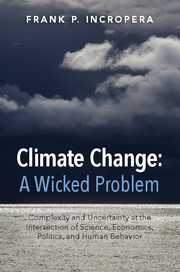 Climate Change: A Wicked Problem
Climate Change: A Wicked Problem Published online by Cambridge University Press: 05 October 2015
The atmosphere is our constant companion. It envelops us 24/7, providing life-sustaining oxygen. In school we learned that, excluding water vapor, nitrogen and oxygen comprise about 98% of the atmosphere's dry air, with argon and carbon dioxide providing much of the remainder. In urban and industrial surroundings, we may also sense the intrusion of atmospheric pollutants such as ozone and sulfur dioxide. In addressing global warming, we turn our attention to atmospheric constituents that qualify as greenhouse gases (GHGs).
The atmospheric concentration of some GHGs is determined by both natural and anthropogenic effects. Hence, the gases would still exist if humans did not inhabit the planet. Water vapor (H2O) and carbon dioxide (CO2) are the biggest contributors to the Earth's natural greenhouse effect, with smaller roles played by methane (CH4) and nitrous oxide (N2O). But due to human activities, the atmospheric concentrations of these species are increasing, providing an anthropogenic component to the greenhouse effect. The effect is amplified by the existence of other, strictly anthropogenic GHGs that number in the hundreds (Ramaswamy et al., 2001; Stine and Sturges, 2007).
Distinguishing features
Not all GHGs contribute to global warming in the same way. For one thing, spectral absorption bands corresponding to discrete regions of the electromagnetic spectrum in which the gases absorb terrestrial radiation differ according to their strength and wavelengths. For example, methane molecules absorb terrestrial radiation at different wavelengths and more strongly than carbon dioxide molecules. Also, once released to the atmosphere, gases differ according to the amount of time they remain in the atmosphere.
Distinguishing features of five comparatively long-lived and well-mixed GHGs that account for about 96% of the anthropogenic greenhouse effect are provided in Table 3.1, along with the cumulative effect of fifteen minor, halogenated gases that account for much of the remaining 4%. Containing chlorine, fluorine, and/or bromine, halogens are man-made chemicals used in many industrial processes and commercial products such as refrigerants, aerosols, and foaming agents. Examples include the families of chlorofluorocarbons (CFCs) and hydrochlorofluorocarbons (HCFCs). Halogens containing chlorine or bromine contribute to another environmental problem, namely depletion of stratospheric ozone. While the atmospheric concentrations of CO2, CH4, and N2O are influenced by both natural and anthropogenic effects, the halogens are strictly anthropogenic.
To save this book to your Kindle, first ensure no-reply@cambridge.org is added to your Approved Personal Document E-mail List under your Personal Document Settings on the Manage Your Content and Devices page of your Amazon account. Then enter the ‘name’ part of your Kindle email address below. Find out more about saving to your Kindle.
Note you can select to save to either the @free.kindle.com or @kindle.com variations. ‘@free.kindle.com’ emails are free but can only be saved to your device when it is connected to wi-fi. ‘@kindle.com’ emails can be delivered even when you are not connected to wi-fi, but note that service fees apply.
Find out more about the Kindle Personal Document Service.
To save content items to your account, please confirm that you agree to abide by our usage policies. If this is the first time you use this feature, you will be asked to authorise Cambridge Core to connect with your account. Find out more about saving content to Dropbox.
To save content items to your account, please confirm that you agree to abide by our usage policies. If this is the first time you use this feature, you will be asked to authorise Cambridge Core to connect with your account. Find out more about saving content to Google Drive.